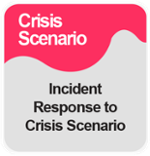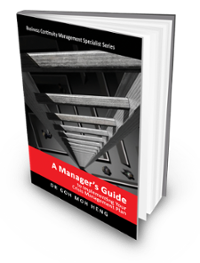Action Steps for Managing a Staff Accident
Description of Crisis
This section details specific actions to take before, during, and after an accident at work.
 This playbook is a training aid for Module 2 Session 2 of the CM-300/ 5000 Implementer/ Expert Implementer Course participants to attempt the CM plan development assignment. This playbook is a training aid for Module 2 Session 2 of the CM-300/ 5000 Implementer/ Expert Implementer Course participants to attempt the CM plan development assignment. |
 |
 Scenario: A staff had a severe accident at work
Scenario: A staff had a severe accident at work
Action Steps for Pre-Crisis
Risk Assessment
-
Identify Potential Hazards: Conduct a comprehensive workplace hazard assessment to identify potential risks that could lead to accidents. This includes:
- Physical hazards (e.g., slippery surfaces, heavy machinery)
- Chemical hazards (e.g., exposure to toxic substances)
- Biological hazards (e.g., exposure to pathogens)
- Ergonomics hazards (e.g., repetitive motions, poor posture)
-
Prioritize Risks: Evaluate the likelihood and severity of each hazard to prioritize risk mitigation efforts.
Emergency Response Plan
- Develop a Comprehensive Plan: Create a detailed emergency response plan outlining procedures for handling various types of accidents.
- Define Roles and Responsibilities: Assign specific roles and responsibilities to employees for emergency response, such as first aid, evacuation, and communication.
- Emergency Contact Information: Ensure that emergency contact information for all employees is updated and easily accessible.
Training and Drills
- Safety Training: Conduct regular training sessions to educate employees about workplace hazards, safety protocols, and emergency procedures.
- Emergency Drills: Conduct periodic drills to practice evacuation procedures, first aid, and communication protocols.
- Feedback and Improvement: Evaluate the effectiveness of training and drills and make necessary adjustments to improve preparedness.
Communication Plan
- Internal Communication: Establish clear communication channels within the organization, including procedures for reporting accidents and incidents.
- External Communication: Develop a plan for communicating with external stakeholders, such as the injured employee's family, media, and regulatory agencies.
Incident Reporting Procedures
- Standardized Forms: Create standardized forms for reporting accidents and incidents.
- Investigation Procedures: Outline procedures for conducting prompt and thorough investigations into accidents.
- Documentation: Ensure that all relevant documentation, such as incident reports, witness statements, and medical records, is adequately maintained.
Action Steps for During-Crisis
Immediate Action
- Activate Emergency Services: If necessary, call emergency services immediately, providing accurate information about the nature of the accident, the injured person's condition, and the location.
- Administer First Aid: If qualified, administer first aid to the injured person while waiting for emergency services.
- Ensure Safety: Assess the situation to ensure the safety of other employees and bystanders. If necessary, evacuate the area or take other precautions to prevent further injuries.
Incident Investigation
- Preserve the Scene: Preserve the accident scene to facilitate an investigation.
- Gather Information: Collect information from witnesses, including their names, contact information, and descriptions of what they observed.
- Document the Incident: Take photos or videos of the accident scene to document the circumstances.
Communication
- Notify Stakeholders: Inform relevant stakeholders, such as the injured employee's next of kin, HR department, and legal counsel, about the accident.
- Follow Communication Plan: Adhere to the established communication plan for internal and external stakeholders.
- Provide Updates: Keep employees and stakeholders informed about the injured person's condition and any ongoing investigations.
Employee Support
- Offer Assistance: Provide emotional support, medical assistance, and information about available resources to the injured employee and their family.
- Accommodate Needs: If injured employees require accommodations or modifications to their work duties, work with them to develop a suitable plan.
Legal Matters
- Consult Legal Counsel: If necessary, consult legal counsel to address legal obligations, such as workers' compensation claims or lawsuits.
- Gather Evidence: Collect and preserve any relevant evidence that may be needed for legal proceedings.
Action Steps for Post-Crisis
Incident Report
- Prepare a Detailed Report: Create a comprehensive incident report that documents the circumstances of the accident, including:
- Date and time of the accident
- Location of the accident
- Names of injured employees and witnesses
- Description of the accident and injuries sustained
- Actions taken during the emergency response
- Relevant documentation (e.g., medical reports, incident photos)
Investigation
- Conduct a Thorough Investigation: Conduct a thorough investigation to identify the root cause of the accident and determine how it could have been prevented.
- Interview Witnesses: Interview employees involved in the accident and any witnesses to gather additional information.
- Review Safety Procedures: Review existing safety procedures and identify any deficiencies or areas for improvement.
Corrective Actions
- Implement Changes: Implement corrective actions to address the root cause of the accident and prevent similar incidents from happening in the future.
- Update Safety Procedures: Modify safety procedures to reflect the lessons learned from the investigation.
- Retrain Employees: Provide additional training on updated safety procedures and best practices.
Employee Support
- Continue to support the injured employee and their family, including assistance with return-to-work arrangements and any necessary accommodations.
- Follow-up: Follow up with the injured employee to ensure their recovery progresses and address ongoing needs.
Legal Matters
- Address Legal Obligations: If legal proceedings are necessary, work with legal counsel to address any workers' compensation claims or lawsuits.
- Gather Evidence: Collect and preserve any relevant evidence that may be needed for legal proceedings.
Review and Update
- Review Emergency Response Plan: Review the emergency response plan and make necessary updates based on the lessons learned from the incident.
- Conduct Regular Drills: Continue to conduct regular safety training and emergency drills to maintain preparedness.
Summing Up ...
 Effectively managing a staff accident requires a comprehensive approach that addresses the injured employee's immediate needs, investigates the incident's root cause, and takes proactive measures to prevent future occurrences.
Effectively managing a staff accident requires a comprehensive approach that addresses the injured employee's immediate needs, investigates the incident's root cause, and takes proactive measures to prevent future occurrences.
By following the guidelines outlined in this playbook, organizations can minimize the impact of accidents, demonstrate a commitment to employee safety, and maintain a positive workplace culture.
This playbook provides a solid foundation for developing and implementing an accident management plan. Regularly reviewing and updating the plan is essential to ensure its effectiveness and relevance in changing circumstances. By taking a proactive approach to workplace safety, organizations can create a safer and more supportive environment for their employees.
Click the right icon to view more "Playbook"s.
Do You Want to Continue Your CM Professional Training with Certification Remotely?
Reference Guide
 Goh, M. H. (2016). A Manager’s Guide to Implement Your Crisis Management Plan. Business Continuity Management Specialist Series (1st ed., p. 192). Singapore: GMH Pte Ltd.
Goh, M. H. (2016). A Manager’s Guide to Implement Your Crisis Management Plan. Business Continuity Management Specialist Series (1st ed., p. 192). Singapore: GMH Pte Ltd.
More Information About Crisis Management Blended/ Hybrid Learning Courses
To learn more about the course and schedule, click the buttons below for the CM-300 Crisis Management Implementer [CM-3] and the CM-5000 Crisis Management Expert Implementer [CM-5].





![[BL-3-Catalog] What Specialist Level Blended Learning Courses that are Available?](https://no-cache.hubspot.com/cta/default/3893111/4b22a53c-6e3e-4b9e-8c2a-888423f1d26c.png)
![[BL-5-Catalog] What Expert Level Blended Learning Courses that are Available?](https://no-cache.hubspot.com/cta/default/3893111/fe175db3-7f57-4636-bf09-e9a836aa5478.png)





![[BL-CM] [5] Register](https://no-cache.hubspot.com/cta/default/3893111/82024308-16f4-4491-98be-818a882c6286.png)

![Email to Sales Team [BCM Institute]](https://no-cache.hubspot.com/cta/default/3893111/3c53daeb-2836-4843-b0e0-645baee2ab9e.png)





